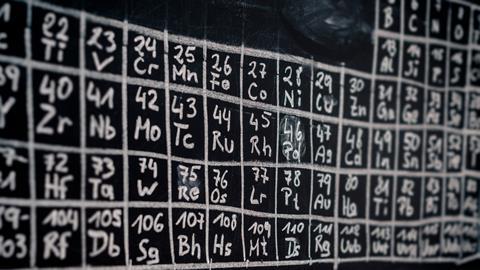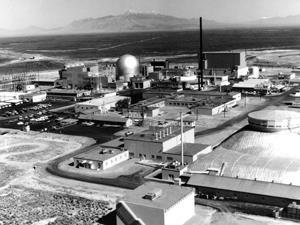Meera Senthilingam
This week, Hayley Birch is challenging a once common truth.
Hayley Birch
In the 1960s, British chemist Neil Bartlett was working in Vancouver at the University of British Columbia. As a lecturer at this time, he would have been bound to teach his students something he didn’t quite believe: that the far right of the periodic table was a dead zone. In those days, scientists thought the noble gases on the right of the table were completely inert. They didn’t react, wouldn’t give up their electrons and couldn’t form compounds. But Bartlett would prove this incontrovertible ‘truth’ quite wrong.

Bartlett had become interested in possible compounds of the noble gas xenon. Back then, looking for noble gas compounds was considered a sort of fringe science akin to hunting for Yeti. But Bartlett was in hot pursuit. He’d noticed that xenon, one of the heavier noble gases, had a similar ionisation potential to oxygen. Today, we refer to ionisation potential as ionisation energy – it’s a figure telling us how easy it is to pull an electron off an atom of a particular element. The higher the number, the more energy is required to prise an electron off in order to get it to react with other elements and form compounds. For a gas like xenon, the ionisation energy can be found by bombarding it with other, fast-moving electrons and working out the energy needed to knock negatively charged electrons off the xenon atoms, producing positively charged ions. Bartlett thought it was curious that xenon had an ionisation energy that was remarkably close to that of oxygen.
Why did oxygen’s stats have any bearing on the matter? Well, oxygen doesn’t usually form positive ions at all. Rather than letting its electrons go, it goes around grabbing extra ones from other elements. Like common bleach, it’s an oxidant. The ionisation figures suggested that it was about as difficult to tear electrons away from oxygen as it was from xenon. Bartlett, however, had stumbled upon a compound that was such a powerful oxidant that it could oxidise oxygen itself, by stealing electrons from it. And if this compound could steal electrons from oxygen, then why couldn’t it steal them from xenon and force it to react?
The super-oxidising compound was platinum hexafluoride, a yellow-brown solid substance recently discovered by Bernard Weinstock and his colleagues at the Argonne National Laboratory in Lemont, Illinois. When they published their discovery in 1957, they had no knowledge of its oxidising abilities. But in his experiments with platinum and fluorine, Bartlett had accidently let some oxygen get into the mix, producing a red substance that for a long while he was unable to identify. He eventually realised that it was platinum hexafluoride that had reacted with oxygen and that the oxygen ions had been oxidised.

Once this became clear, Bartlett was convinced that the textbooks were wrong and that he could also get xenon to react with the super-oxidant. He set about trying to prove it, culminating in an experiment in March 1962 that would change the way scientists thought about the noble gases for good. The concept couldn’t have been simpler: take xenon, in one flask, and vapour of platinum hexafluoride in another, and let them mix together. In those days, though, you often had to make your own glassware and since none of Bartlett’s labmates were as skilled in that art as he was, it was the end of a long week of glassblowing – and preparation of the platinum hexafluoride – before he got to test this concept.
By the Friday evening, the lab was already empty and Bartlett was left to fill the two flasks on his own. He broke the seal between them and waited for the red vapour of platinum hexafluoride to mix with the colourless xenon gas contained in the other flask. “There was an immediate interaction,” he wrote, some decades later, in a book about fluorine chemistry. The orangey-yellow solid formed right in front of his eyes. He became the first to see something no other scientist had yet seen – a compound of xenon.
With very little fanfare, Bartlett announced his findings in a three-paragraph long report in Proceedings of the Chemical Society. In the third paragraph, he wrote ‘[This] compound is believed to be the first xenon charge-transfer compound which is stable at room temperatures.’ Once word got out, it wasn’t long before other scientists were helping to rewrite the textbooks. Xenon hexafluoroplatinate was just the first in a long line in of noble gas compounds to emerge. We now know of hundreds, proving that it should be the business of scientists to keep on challenging the accepted ‘truth’, even when it seems incontrovertible.
Meera Senthilingam
Science writer Hayley Birch, revealing the true chemistry of xenon, through its original alter ego: Hexafluroplatinate.
Next week, more discovery, and naming, of compounds. But this time there’s less pride in the outcome.
Brian Clegg
There’s an undoubted cachet in having a product or substance named after you. But it’s arguable that one compound no one wants to be remembered for is a chemical weapon – yet such was the burden of the US chemist, Winford Lee Lewis, who had the doubtful honour of having lewisite named after him.
Meera Senthilingam
Find out its use during warfare in next weeks Chemistry in its Element. Until then, thank you for listening I’m Meera Senthilingam.













No comments yet